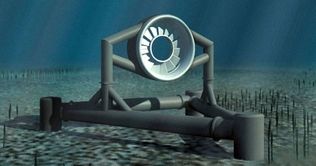By Chris Winters Friday, March 21, 2014
Herald Writer
EVERETT — The Snohomish County Public Utility District on Thursday received federal approval for plans to place two large turbines on the sea floor off Whidbey Island.
The pilot project has been in development for years, and if the PUD’s Board of Commissioners signs off on the project, it may be a few more years before the turbines are installed.

This artist’s rendering shows the tidal energy turbine Snohomish County Public Utility District plans to test to determine if tidal energy is a viable source of electricity.
The project is a test to see if using tides to generate electricity is technically, commercially and environmentally viable, said Craig Caller, an assistant general manager for the PUD.
It would be the first time tidal power turbines in Puget Sound would be connected to the larger electricity grid.
So far, the PUD has raised about $13 million in federal Department of Energy grants, which is expected to cover about half the cost of the project. The rest would come from a mix of more grants and money from the utility’s Resource Reinvestment Reserve, Caller said.
The test area is 200 feet deep in Admiralty Inlet, less than half a mile off the west shore of Whidbey Island and not far from the Keystone ferry slip and Fort Casey State Park.
The utility is to operate the turbines for three to five years, during which time it will study the turbines’ actual performance versus the expected output, maintenance requirements, underwater noise and response of nearby fish and marine mammals.
Gathering that data will determine whether the utility proceeds with a commercial deployment. Right now there isn’t enough data to make even an educated guess as to tidal power’s viability.
“It’s in its infancy. It’s about where wind technology was decades ago,” said Dave Aldrich, president of the PUD’s Board of Commissioners.
In issuing the license, the Federal Energy Regulatory Commission (FERC) ruled that the PUD has addressed concerns raised by Native American tribes and an undersea cable company.
The Tulalip Indian Tribes, the Suquamish Tribe and the Point No Point Treaty Council, representing the Port Gamble and Jamestown S’Klallam tribes, opposed the project, saying the turbines posed a risk to fish and fishing nets and would force the state to close the area to fishing.
A data communications company, Pacific Crossing of Danville, Calif., also protested the project. The company operates more than 13,000 miles of undersea fiber-optic cable that pass through Admiralty Inlet to Harbour Pointe from Asia and California. It is concerned cables would be damaged by the operation of the turbines.
Caller said that FERC in its ruling said the turbines posed no risk either to undersea cables or marine wildlife, nor would they impede the tribes’ fishing rights.
Officials from the Tulalip Tribes and Pacific Crossing could not be reached for comment.
In the Orkney Islands off the coast of Scotland, another pilot project using the same model of turbines found there was no danger to wildlife.
“What they found consistently over that time is that when the turbine is rotating, that fish and mammals simply avoid it,” Caller said.
The turbines are to be made by the Irish firm OpenHydro. They are approximately 20 feet in diameter, weigh 414 tons each and sit 65 feet high on a triangular platform 100 by 85 feet.
At peak generation, the turbines could produce 600 kilowatts of electricity. But because this is a pilot project, it is unlikely the turbines would ever generate that much electricity for the grid, Caller said,
If the PUD’s board votes to move forward with the project — Aldrich said it likely will — the utility will need to obtain permits from Island County, where the power would be brought to shore, order the turbines and hire contractors.
It’s brand new territory for the utility, and installation of the turbines is years away.
“We’re pioneers if we go through with this,” Aldrich said.
Chris Winters: 425-374-4165 or cwinters@heraldnet.com.
